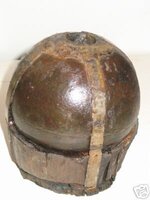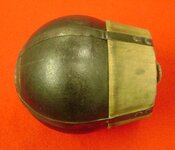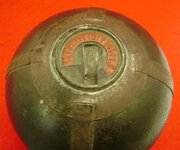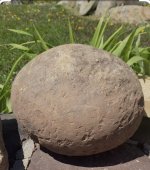ChopperGuy
Newbie
- Jan 22, 2014
- 4
- 2
- Primary Interest:
- All Treasure Hunting
Hello everyone,
I am new to this site and found treasurenet while attempting to do some research on a recent "barn find". The ball I found weighs 16.5 pounds, but it does have some sort of hard residue inside the hollow cavity that you can hear clunking around when you shake the ball. It is very rusty and pitted and measures anywhere from 5.48" to 5.54" in diameter depending on where you measure it. It was measured with a surface plate and digital height gauge. The threaded and counterbored hole has a diameter of 1.65" on the larger bore and 1.05" diameter for the hole that penetrates into hollow cavity. The ball also has 4 pronounced ridges on the first half of the ball starting on the side where the holes are. So, the big questions are what is it, what time period does it appear to be from and does it have any value. I do not plan to sell, just curious mainly. Thanks in advance for the help! I have attempted to attach a couple of photos. One more detail, both the 1.65 counterbore hole and the 1.05 through hole is threaded. I cannot tell what thread size due to rust / corrosion.
I am new to this site and found treasurenet while attempting to do some research on a recent "barn find". The ball I found weighs 16.5 pounds, but it does have some sort of hard residue inside the hollow cavity that you can hear clunking around when you shake the ball. It is very rusty and pitted and measures anywhere from 5.48" to 5.54" in diameter depending on where you measure it. It was measured with a surface plate and digital height gauge. The threaded and counterbored hole has a diameter of 1.65" on the larger bore and 1.05" diameter for the hole that penetrates into hollow cavity. The ball also has 4 pronounced ridges on the first half of the ball starting on the side where the holes are. So, the big questions are what is it, what time period does it appear to be from and does it have any value. I do not plan to sell, just curious mainly. Thanks in advance for the help! I have attempted to attach a couple of photos. One more detail, both the 1.65 counterbore hole and the 1.05 through hole is threaded. I cannot tell what thread size due to rust / corrosion.
Amazon Forum Fav 👍
Attachments
Last edited:


![IMG_20140122_102956_178[1].jpg](/data/attachments/878/878125-854c40eb4ad91ace765831558f866e95.jpg)
![IMG_20140122_102948_202[1].jpg](/data/attachments/878/878110-64ff159da13bc98bea7f3cd516156f73.jpg)





